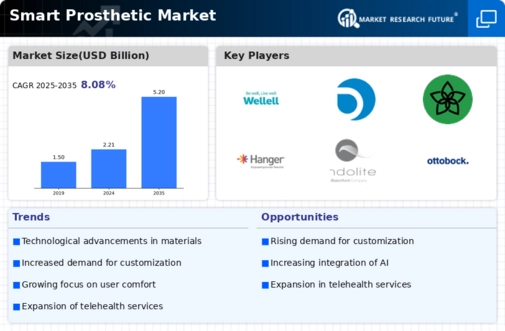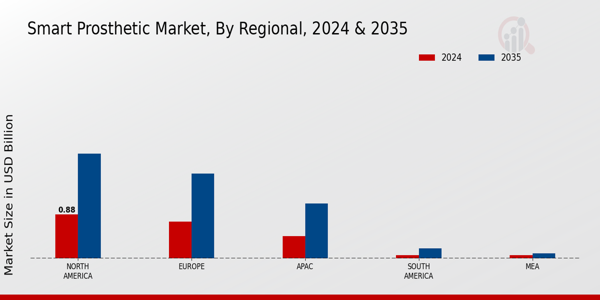Aging Population
The Global Smart Prosthetic Market Industry is also shaped by the aging population, which is more susceptible to conditions leading to limb loss. As life expectancy increases, the number of elderly individuals requiring prosthetic solutions is likely to rise. This demographic shift creates a substantial market opportunity for smart prosthetics that cater to the unique needs of older adults. With advancements in technology, these devices can offer enhanced mobility and independence, which are crucial for this age group. The market is expected to grow at a CAGR of 8.09% from 2025 to 2035, reflecting the increasing demand for innovative solutions tailored to the aging population.
Market Growth Projections
The Global Smart Prosthetic Market Industry is projected to experience substantial growth over the coming years, with forecasts indicating a market value of 5.2 USD Billion by 2035. This growth is underpinned by a compound annual growth rate (CAGR) of 8.09% from 2025 to 2035, suggesting a robust demand for innovative prosthetic solutions. Factors contributing to this growth include technological advancements, rising incidence of limb loss, and an aging population. As the market evolves, stakeholders are likely to focus on enhancing product offerings and expanding access to smart prosthetics, ensuring that a broader range of individuals can benefit from these life-changing technologies.
Technological Advancements
The Global Smart Prosthetic Market Industry is experiencing rapid growth due to continuous technological advancements. Innovations in materials and electronics have led to the development of prosthetics that are lighter, more durable, and capable of mimicking natural limb movements. For instance, the integration of artificial intelligence and machine learning enables these devices to adapt to users' movements in real-time, enhancing functionality and user experience. As of 2024, the market is valued at 2.21 USD Billion, reflecting a strong demand for these advanced solutions. This trend is expected to continue, as ongoing research and development efforts aim to improve the performance and accessibility of smart prosthetics.
Rising Incidence of Limb Loss
The Global Smart Prosthetic Market Industry is significantly influenced by the rising incidence of limb loss due to various factors, including accidents, diabetes, and vascular diseases. According to health statistics, the prevalence of diabetes-related amputations is increasing, which necessitates the need for advanced prosthetic solutions. This growing patient population drives demand for smart prosthetics that offer improved functionality and comfort. As the market evolves, it is projected to reach 5.2 USD Billion by 2035, indicating a robust growth trajectory. The increasing awareness and acceptance of prosthetic devices among patients further contribute to this trend, highlighting the importance of addressing limb loss challenges.
Government Initiatives and Funding
Government initiatives and funding play a pivotal role in the growth of the Global Smart Prosthetic Market Industry. Various governments are recognizing the importance of providing support for individuals with disabilities, leading to increased funding for research and development in prosthetic technologies. Initiatives aimed at improving healthcare access and affordability for prosthetic devices are gaining traction. For example, subsidies and grants for innovative prosthetic solutions can enhance patient access to advanced technologies. This supportive environment is likely to foster innovation and drive market growth, as stakeholders collaborate to develop cost-effective solutions that meet the needs of diverse populations.
Increased Awareness and Acceptance
Increased awareness and acceptance of smart prosthetics are crucial drivers for the Global Smart Prosthetic Market Industry. Educational campaigns and advocacy efforts are helping to destigmatize the use of prosthetic devices, encouraging more individuals to seek solutions for limb loss. As societal perceptions shift, the demand for advanced prosthetics that offer improved functionality and aesthetics is likely to rise. This trend is further supported by testimonials from users who share their positive experiences with smart prosthetics, showcasing the benefits of these technologies. As awareness continues to grow, the market is poised for substantial expansion, reflecting changing attitudes towards limb loss and rehabilitation.













